

 |
 |
| Home>New Photos >Normandy |
Normandy, France Photos These photos are from our trip to Normandy, France in June, 2008. They include photos of Monet's Gardens, Honfleur, the D-Day landing beaches, Caen, and Mont-St-Michel. We rented a Mini Cooper at Charles de Gaulle Airport on June 18, installed our Tom Tom GPS unit, and headed east to Normandy. Our first stop was in Givernery where we made a short photo tour of Monet's Gardens. We then drove to nearby Honfleur and checked in to Ferme St. Simeon, which is very nice with an excellent restaurant. On June 19, we toured Honfleur in a light rain and then headed to Caen for our next stop. We stayed two nights in Caen using the city as our base for a day long tour of the main reason we came to Normandy, the D-Day Beaches. Our visit to the Operation Overlord landing beaches was an impressive and emotional tour, especially Omaha Beach. We talked with a grandfather who was at Normandy who is now taking his grandchildren to the places he went in harm's way in 1944. After Caen, we drove to Mont Saint Michel and checked in to the La Mere Poulard Hotel which is just inside the gates. We enjoyed the famous omelettes for lunch and again with dinner. We spent Sunday morning touring the monastery, which involves a lot of stair climbing. We then checked out and headed back to Paris to catch a morning flight to Munich where we connected with our granddaughter. The pictures tell a much better story. It was a wonderful trip. BTW, the Mini Copper was made for these roads. |
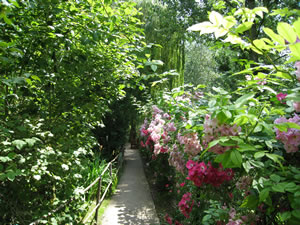 |
If you visit the Musée de l'Orangerie in Paris you will see Monet's famous Nymphéas painting which will inspire you to visit Giverny to tour Monet's home, gardens and pond. Our mid-week June visit found the site quite light in tourists. Giverny is just 1 hour from Charles de Gaulle airport if the traffic is light. |
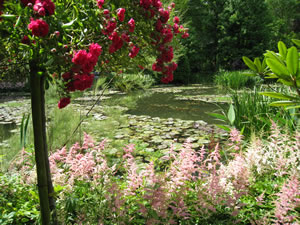 |
This photo is one of many we took at Monet's lilly pond. |
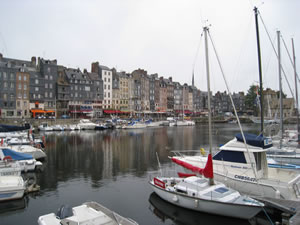 |
Honfleur was the port where Samuel de Champlain set sail for Canada in 1608 where he founded Quebec. Honfleur has been and still is an Artist's Paradise. It is located across the Seine Bay from near Le Havre. |
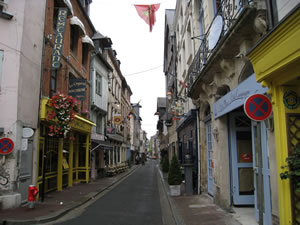 |
We took a walking tour of two streets in Honfleur that contained very old homes and shops. |
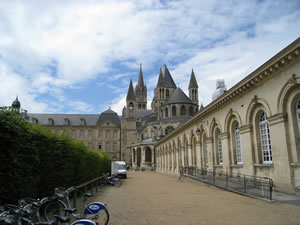 |
Caen was severely damaged during the Battle of Normandy in 1944. The city was rebuilt and is a charming place. Caen was the favorite residence of William the Conqueror and Queen Matilda in the mid-11th century. This photo shows the church Eglise St-Etienne of the Abbaye-aux-Hommes, which was built by William. |
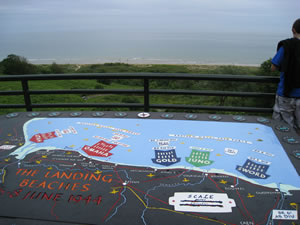 |
This map is located in the American Cemetery above Omaha Beach. We started our tour in Ouistreham and drove along the coast road through the Sword, Juno, Gold, and Omaha landing beaches finishing up at Pointe du Hoc. |
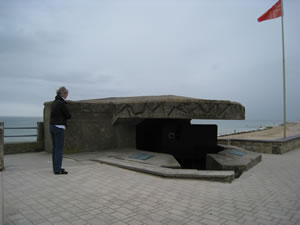 |
This German gun bunker is positioned to control the coastal road. It can fire down the road in either direction. Note that its sea side is solid concrete. |
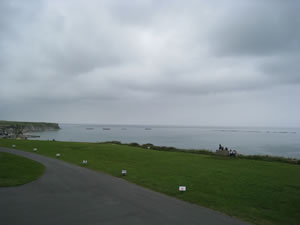 |
This photo shows the remains of the Mulberry harbor which was a prefabricated port that was constructed in England and towed to Normandy and placed at Arromanches. |
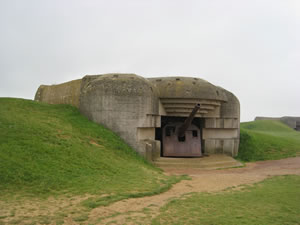 |
This photo shows one of the four German 150mm guns at Longues sur Mer. The guns were heavily bombed during the night but remained operational for most of June 6th, 1944 until they were silenced by naval fire. An observation post on the sea cliff controlled the gun's targeting. |
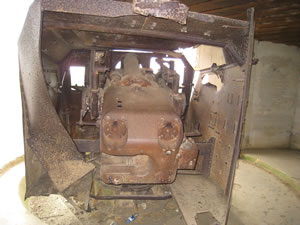 |
This photo shows a gun from inside the bunker. Note the damage to the right side. |
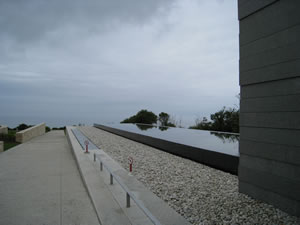 |
Looking out to the English Channel from the memorial located at the American Cemetery above Omaha Beach |
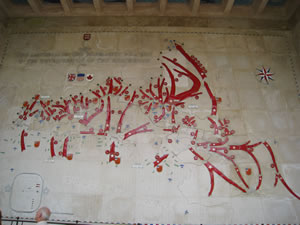 |
The memorial has many annotated maps illustrating the invasion and the following Battle of Normandy. This map shows the landing locations and the development of the beachheads. |
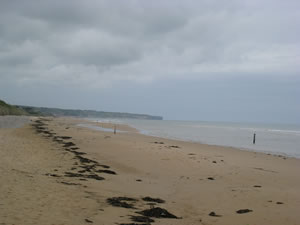 |
We walked down the bluff from the American Cemetery and stood in the sand at Omaha Beach. I suggest watching the start of Saving Private Ryan as a reminder of what the Americans faced as they landed here on June 6, 1944. |
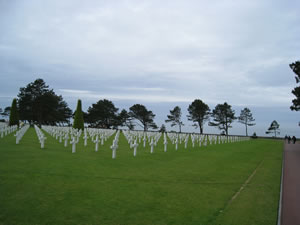 |
This photo shows just a part of the American Cemetery that overlooks Omaha Beach. The Michelin Guide states that there are 9,385 marble marble crosses and Stars of David here. |
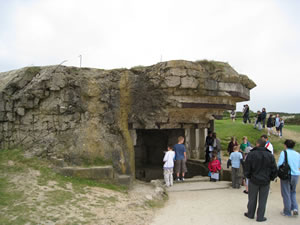 |
This photo shows one of the gun bunkers located at Pointe du Hoc. American Ranger's scaled the cliffs to seize the area. The Germans had moved the guns inland but still fought hard to defend the strategic point. |
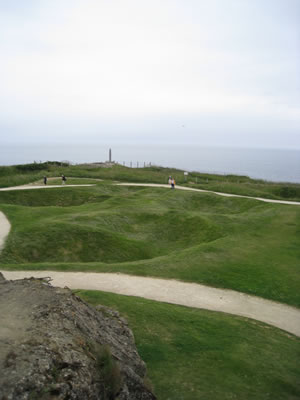 |
President Reagan, June 6, 1984: "Behind me is a memorial that symbolizes the Ranger daggers that were thrust into the top of these cliffs. And before me are the men who put them there. These are the boys of Pointe du Hoc. These are the men who took the cliffs. These are the champions who helped free a continent. These are the heroes who helped end a war. Gentlemen, I look at you and I think of the words of Stephen Spender's poem. You are men who in your "lives fought for life...and left the vivid air signed with your honor…." |
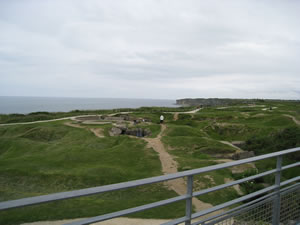 |
Pointe du Hoc received heavy air and naval bombardment. The landscape is marked with craters. |
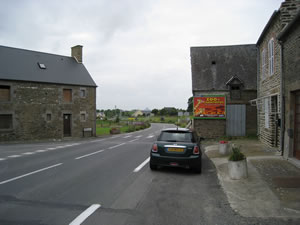 |
Here is our Hertz Mini Cooper on the road to Mont-St-Michel, which you can see in the distance. The Mini was perfect for this road trip. |
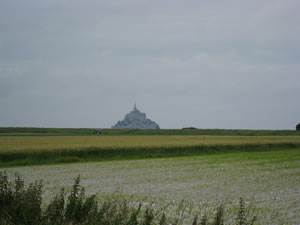 |
Mont-St-Michel is an enchanting sight as it rises from the horizon. It is located on border between Normandy and Brittany. |
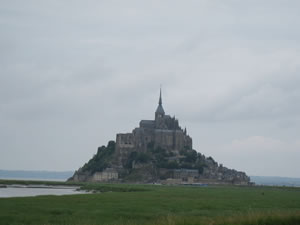 |
In this photo, you can now see the details of the Benedictine Abbey and lower town. |
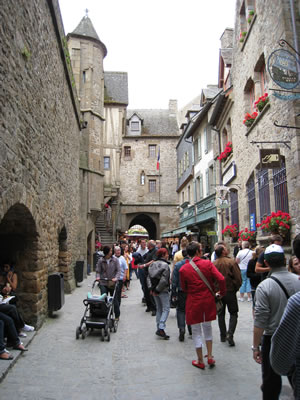 |
Mont-St-Michel's Grand Rue has many shops and restaurants. |
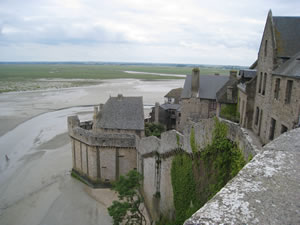 |
This is a good view of the ramparts that protected Mont-St-Michel from English attacks during the Hundred Years War. |
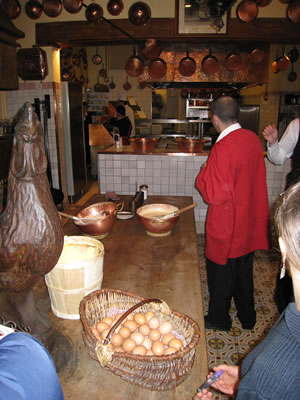 |
The kitchen of the La Mere Poulard Hotel. Annette Poulard made the famous airy omelettes for travelers who arrived tired and hungry starting about 1875. They are the signature dish today.
|
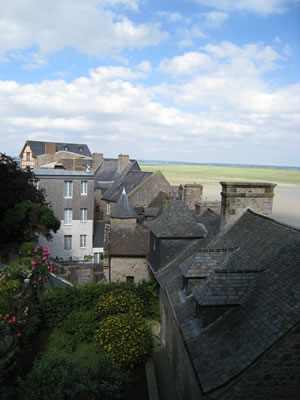 |
A view from our room at La Mere Poulard Hotel. According to the New York Times, "Everybody who was anybody went to La Mere Poulard: the Roosevelts (Theodore, Franklin and Eleanor), Trotsky, Lindbergh, Hemingway, Rita Hayworth, Yves Montand, Maurice Chevalier, Margaret Thatcher, Coco Chanel." |
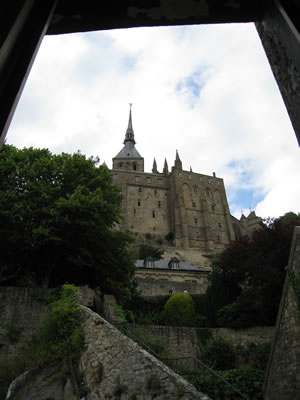 |
Another view from our room. This 4th floor view came at a price because we had to haul our luggage up many flights of stairs. Pack lightly! As I was descending the stairs on one of my many round trips, I came across an exhausted lady who was sitting on her suitcase at the third floor landing. She looked up at me and said,"The exercise class didn't work." |
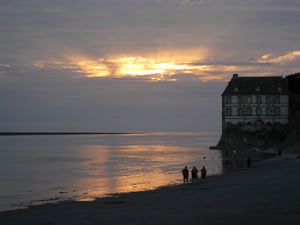 |
We walked out to the causeway at sunset to take some evening pictures of Mont-St-Michel as the sun set and the lights came on. |
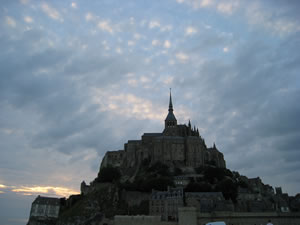 |
Mont-St-Michel just after sunset. |
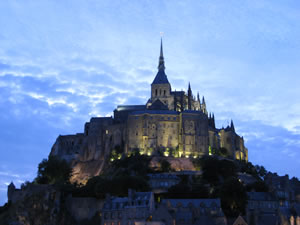 |
Mont-St-Michel just after the lights came on. |
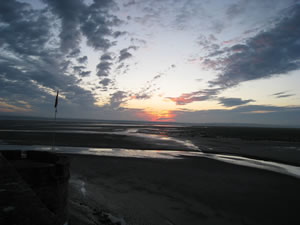 |
I was up before dawn to capture the sunrise from the Mont-St-Michel ramparts. |
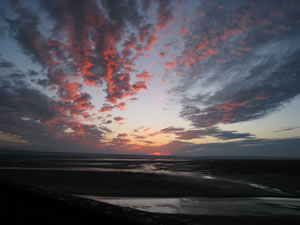 |
Sunrise at Mont-St-Michel. |
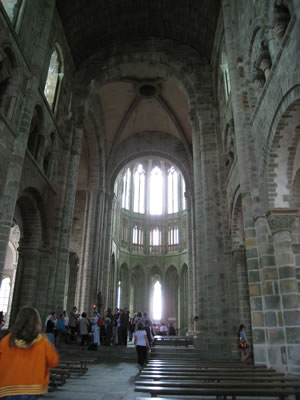 |
The Romanesque church of Mont-St-Michel. It is quite a climb to reach this point. |
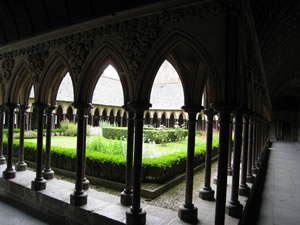 |
A view of the Cloisters at Mont-St-Michel. |
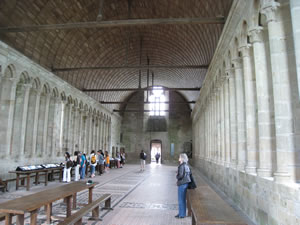 |
The Refectory where the monks took their meals. |
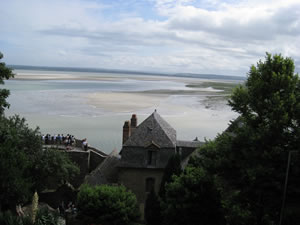 |
Leaving the Abbey, we took this last photo showing the bay. The walk down was much easier. |